
Contents
Letter from the President, Martha Reineke
Editor’s Column, Curtis Gruenler
COV&R Sessions at the American Academy of Religion
COV&R Annual Meeting at Purdue University, Lafayette, Indiana, USA
COV&R Annual Meeting, University of Innsbruck, Stephen McKenna
Scott Cowdell, René Girard and the Nonviolent God, reviewed by Ann Astell
Sandor Goodhart, Möbian Nights: Reading Literature and Darkness, reviewed by Ann W. Astell
Letter from the President
Martha Reineke
University of Northern Iowa
Just over a month ago, many of us gathered at the University of Innsbruck, where our hosts, led by Nikolaus Wandinger and Dietmar Regensburger, had planned a memorable meeting on the challenging dynamics of exclusion and desire in an age of worldwide migration. That, during the concurrent sessions, I wanted to be in three places at once attests to the quality and significance of the individual presentations. The plenary speakers also made notable contributions to our reflections on the conference theme. They demonstrated compelling expertise in their areas of research specialization; moreover, speakers who were not previously familiar with mimetic theory had made strong efforts to learn its key features in order to facilitate productive conversations with the audience. I extend heartfelt thanks to the planning committee for the outstanding success of their efforts on our behalf.
I am honored to be the newly elected President of COV&R. Stepping into this role is more than a bit daunting. Outstanding leadership in recent years—Wolfgang Palaver, Ann Astell, and Jeremiah Alberg—presents me with multiple pairs of big shoes to fill. The current vitality of the organization is very much due to their efforts and wisdom. As I’ve tried to get a grip on the jitters, I’ve realized that I am surrounded by a wonderful support team. I worked with Nikolaus Wandinger when I was coordinating COV&R events at the AAR. He was a valued partner in that effort, and I am thrilled that he has accepted the nomination to become our Executive Secretary. Moreover, the COV&R Board is amazing. At our board meeting at Innsbruck, as I looked around the table at all the folks who guide our little ship, I realized how blessed we are by the wealth of abilities and commitment to this organization represented by our board. In Innsbruck, we expressed our appreciation to our outgoing board member, Joachim Duyndam, and welcomed two new board members: Stephen McKenna and Erik Buys. We also are pleased (and relieved) that Curtis Gruenler, editor of the Bulletin, and Grant Kaplan, coordinator of our sessions at the annual meetings of the American Academy of Religion, accepted second terms. Each plays a key role in making mimetic theory visible to our members and to individuals we hope will discover mimetic theory. Rounding out our network of support are our eleven partner organizations. They add so much to our organization. Particularly close ties exist between COV&R and several of these organizations: On our COV&R board sit individuals associated with RGKW at Innsbruck, the Australian Girard Seminar, Theology and Peace, and the Raven Foundation. The creative synergy linking our partner organizations and COV&R strengthens all of us. In the years ahead, the ongoing vitality of COV&R will further be assured by our enhanced international presence. We’re looking forward to our first annual meeting in South America in Bogota in 2021 hosted by Roberto Solarte. And we hope to enhance knowledge of mimetic theory in Eastern Europe by having our COV&R meeting in 2022 in Romania, hosted by Marinela Blaj.
Particularly important to the future of COV&R is the ongoing discovery of Girard and mimetic theory by new generations of scholars and practitioners. My favorite aspect of each annual gathering is talking with our first-time attendees and listening to papers offered by our Schwager Award winners. Many years ago, Jim Williams, one of the senior members of the Girardian community, welcomed me to my first COV&R meeting. I felt at home and appreciated — which are uncommon feelings for a newly minted PhD at a professional meeting. All of us in COV&R want these feelings to be our shared experience. One of my primary goals as president is to insure that our new members feel welcome, find in COV&R a caring and supportive intellectual community, and want to return to our annual meetings year after year. I hope that when I am attending a COV&R meeting as a little, old blue-haired lady of 95, someone for whom the 2019 meeting in Innsbruck was their first meeting will be elected COV&R president!
I’d like to reprise here my tribute to our outgoing president, Jeremiah Alberg, offered at our closing banquet in Innsbruck. Over the years, I’ve come to realize that the most effective leaders put out fires before they get started. Jay’s leadership wasn’t always visible to the larger body of COV&R members because his impeccable judgment, thoughtful and caring demeanor, as well as his kindness and astute interpersonal insights, often were primarily visible behind the scenes, as he engaged COV&R members, the board, and its officers in conversations that resulted in COV&R functioning smoothly over all the years of his leadership. We are all deeply indebted to Jay for his inspired leadership.
 It’s customary to give a gift to our outgoing president, and I chose for Jay a gift that is a bit of a “spirit animal.” I suggest that an octopus is a fitting choice for the president of an organization that focuses its attention on key features of mimesis: the complex play of desire, the “other” who is both model and threat, and the hope for positive mimesis. Many candidates for spirit animals seem similar to humans: primates, social animals that live in groups such as elephants, even the dogs who our friends tell us bear a striking resemblance to their owners. By contrast, as reported in the wonderful book, The Soul of the Octopus, an octopus is highly dissimilar to humans: It has three hearts, a brain that wraps around its throat, and a covering of slime instead of hair. And its blood is blue because copper rather than iron carries its oxygen. Yet Henry Beston, an American naturalist cited in The Soul of the Octopus, wonderfully reminds us of the essential otherness of all animals when he writes, “They are not our brethren, they are not our underlings but beings gifted with extensions of the senses we have lost or never attained, living by voices we shall never hear.” Nevertheless, viewed from such a perspective, the octopus’s otherness is extreme. Not so much a visitor from another nation, the octopus is perceived by some persons more like an alien from a distant and menacing galaxy.
It’s customary to give a gift to our outgoing president, and I chose for Jay a gift that is a bit of a “spirit animal.” I suggest that an octopus is a fitting choice for the president of an organization that focuses its attention on key features of mimesis: the complex play of desire, the “other” who is both model and threat, and the hope for positive mimesis. Many candidates for spirit animals seem similar to humans: primates, social animals that live in groups such as elephants, even the dogs who our friends tell us bear a striking resemblance to their owners. By contrast, as reported in the wonderful book, The Soul of the Octopus, an octopus is highly dissimilar to humans: It has three hearts, a brain that wraps around its throat, and a covering of slime instead of hair. And its blood is blue because copper rather than iron carries its oxygen. Yet Henry Beston, an American naturalist cited in The Soul of the Octopus, wonderfully reminds us of the essential otherness of all animals when he writes, “They are not our brethren, they are not our underlings but beings gifted with extensions of the senses we have lost or never attained, living by voices we shall never hear.” Nevertheless, viewed from such a perspective, the octopus’s otherness is extreme. Not so much a visitor from another nation, the octopus is perceived by some persons more like an alien from a distant and menacing galaxy.
The notion of a wholly alien other captures much of what we concern ourselves with as students of mimetic theory who find ourselves developing a heightened sensitivity to the challenges of living with and among each other. We become ever more aware of the potential dangers of experiencing others as alien. Moreover, we know, from Girard, that what bothers us most about that other is its potential for similarity: The closer it comes, the more it is experienced as threatening. For all its monstrous appearance, the octopus, as described in the Soul of the Octopus, is among the most mimetic of creatures with an all but fantastic capacity to generate spots, stripes, or blotches of color anywhere on its body in order to blend with its surroundings. It can create moving patterns or light shows. One, called “Passing Cloud” because the pattern on the octopus’s body moves like a cloud across a landscape, gives the impression that the octopus is sand moving along the floor of the ocean. The octopus can raise and lower projections on its body and change its shape, moving through and among impossibly small spaces. Scientists tell us these behaviors are learned. The octopus uses these capacities to defuse potential violence. Adapting its colors and shapes to specific predators, melding with its environment, the octopus enjoys a long life. In a research setting, interacting with humans, the octopus also displays rich potential for positive mimesis: Each octopus responds to its caretaker in a unique way, empathetically winding its long arms around the person who cares for it and making regular eye-to-swiveling-eye contact.
It seems to me that one who lives out the positive insights of mimetic theory evinces an octopus-like hope, believing that across all barriers, under the most alien of circumstances, humans will be able to summon exceptional powers of communication—to make of our bodies passing clouds on the surface of the land that disarm the stranger and enable us to reach out and wrap our arms around even the most different among us—because across all barriers, we share in our souls a deep capacity for empathy. Jay exemplifies such hope, suggesting to me that the octopus is his “spirit animal. On behalf of the entire membership of COV&R, I thank Jay for his years of service to us and for modeling for us the most hopeful insights of mimetic theory.
Editor’s Column
Transitions
Curtis Gruenler
Hope College

With our new president, Martha Reineke, I want to thank Nikolaus Wandinger and Dietmar Regensburger and the rest of the team that organized our meeting last month in Innsbruck. It was a convivial time in every way. Over dinner the first evening, Woody Belangia suggested the term “convivial” as a good modifier for positive mimesis, and I think it fit our theory and practice very well.
I also want to echo Martie’s thanks to Jay Alberg for his tenure as COV&R president. He has been president the whole time I have edited the Bulletin, and I have greatly appreciated his attentive, encouraging, and gentle leadership, especially in the transition to the new, web-based format. I’m also delighted to continue working with Martie in her new role and with Niki, my predecessor as editor, as our new executive secretary.
New Bibliography: As Dietmar Regensburger announced at the annual meeting, most of the bibliographic entries of publications pertaining to mimetic theory that have been published in separate volumes of the Bulletin and on the COV&R website over the years have now been incorporated into the searchable Index Theologicus database. This is described on the bibliographies page of the COV&R website, and there is a link that takes you to the Index Theologicus website and executes a search to retrieve items pertaining to mimetic theory, which can then be further refined. Thanks to Dietmar for all of his work in transferring the data.
Contagion access: The 2019 issue of COV&R’s annual journal was published in May. Publication is now electronic only, using two standard platforms for journal, Project Muse and JSTOR. Many libraries have subscriptions to these sites, so for many members it will be simplest to access Contagion through the portal your library uses for journal databases and electronic subscriptions. COV&R members also have access to Contagion on JSTOR through our membership services provider, PDC.net. You should have received information when you subscribed or renewed about how to access Contagion, but here they are. Go to the PDC site through this link, which is at the bottom of every page on the COV&R website. Once there, use the link in the upper right corner to log in, and then move your cursor to the “MORE CONTENT” tab along the top, which will then display a link to click on to access Contagion at JSTOR. You may find, if you are using a computer that is already logged in to a library website (like mine is whenever I use it my college office), that when you try to log in on PDC, it takes you to a list of journals hosted there that your library is already subscribed to, as well as a long list of other journals that are freely available from PDC, and that Contagion is not listed (probably because the library already has access to it through Project Muse and/or JSTOR and doesn’t need to subscribe through PDC). You could switch accounts (from the SUPPORT tab along the top), but it might be easier to go through the library’s page for accessing journals. In my case, if I am at my office I go to the library’s search page and search for the journal title Contagion, but if I am at home I log in to PDC. If you would like to receive a paper copy by mail, contact MSU Press or the editor, William Johnsen.
Reviews: We’re making some progress this issue in catching up with the backlog of books that deserve to be reviewed here, and there will be more on the way in upcoming issues, thanks to the reviewers and our book review editor, Matthew Packer. We are interested in reviews of any books pertaining to mimetic theory, the volume of which seems to be growing. If you are interested in reviewing a book, please contact Matt. Or consider writing reviews of mimetic theory books for other publications you read, or asking colleagues to consider doing so.
MSU Press books: Members (except for those who joined recently) should have received two spring books from Michigan State University Press: Reflection in the Waves: The Interdividual Observer in a Quantum Mechanical World by Pablo Bandera (from the series Breakthroughs in Mimetic Theory), and Shakespearean Cultures: Latin America and the Challenges of Mimesis in Non-Hegemonic Circumstances by João Cezar de Castro Rocha (from the series Studies in Violence, Mimesis & Culture). Two books are scheduled for this fall: (New) Fascism: Contagion, Community, Myth by Nidesh Lawtoo and The Oedipus Casebook: Reading Sophocles’ Oedipus the King, edited by Mark Anspach.
A student poem: For my fellow teachers starting another school year, I want to share (with permission) a poem written by one of my students last semester in my course on British literature to 1800. We used mimetic theory as a lens for interpreting some of the works we read, and in her final essay, Annie Cerovich included a poem that “works to highlight the primary desires of the protagonists from six narratives”: Sir Gawain and the Green Knight, The Merchant’s Tale from Chaucer’s Canterbury Tales, Shakespeare’s Twelfth Night, Milton’s Paradise Lost, Haywood’s Fantomina, and Swift’s Gulliver’s Travels. It reminds me of the wonderful, creative things that can come from teaching with mimetic theory.
A Pantoum on Relational Dynamics
Inspired by Rene Girard’s Mimetic Theory
By Annie Cerovich
These desires are not mine
Arthur wanted to fight, yet Gawain went
Is that honor, or just a mime?
January had May and Damian laments
Arthur desired to fight, yet Gawain went
Satan grasped at divinity and was disgraced
January had May and Damian laments
To become desirable, Fantomina was erased
Satan grasped at divinity and was disgraced
Gulliver traveled and lost his identity
To become desirable, Fantomina was erased
A triangle: Viola, Orsino, Olivia, no serenity
Gulliver traveled and lost his identity
Is that honor, or just a mime?
A triangle: Viola, Orsino, Olivia, no serenity
These desires are not mine
Forthcoming Events
COV&R at the American Academy of Religion
San Diego, California, Nov. 23-26, 2019

COV&R will have two sessions at this year’s meeting of the Academy of Religion and Society of Biblical Literature, the largest annual meeting of scholars of religion in North America.
Session P23-104, Saturday, 9-11:30am
Girard the Provocateur: Exploring Mimetic Escalation in Dangerous Times
Moderator: Grant Kaplan, Saint Louis University
Panelists:
- Charles Bellinger (Brite Divinity School), “The Kierkegaard-Girard Option in a Polarized Age”
- Artur Rosman (McGrath Institute for Church Life, University of Notre Dame), “Deceit, Desire, and the Kingdom”
- Kevin Hughes (Villanova University), “Religion, Identity, and the Catholic University: A Case of Mimetic Escalation”
Session P24-103, Sunday, 9-11am:
Mimesis and Sacrifice: Applying Girard’s Mimetic Theory Across the Disciplines
Moderator: Marcia Pally, New York University, Humboldt University-Berlin
Panelists:
- Marcia Pally (New York University, Humboldt University-Berlin), “Contemporary Notions of Sacrifice: Suicide Bomber or Social Glue?”
- Anna Mercedes (College of Saint Benedict and Saint John’s University), “Does Christ Resist or Bow Out? Feminist Theology, Violence, and René Girard”
- Wolfgang Palaver (University of Innsbruck), “Sacrifice Between West and East: René Girard, Simone Weil, and Mahatma Gandhi on Violence and Non-Violence”
- David Pan (University of California/Irvine), “Immanuel Kant on Sacrifice and Morality”
- Ilia Delio (Villanova University), “Suffering and Sacrifice in an Unfinished Universe: A Challenge for ‘Techno-sapiens’”
For more information, see the conference website or contact COV&R’s AAR liaison, Grant Kaplan.
COV&R Annual Meeting 2020:
Mimetic Theory and Artificial Intelligence
Purdue University, West Lafayette, Indiana, July 8-12
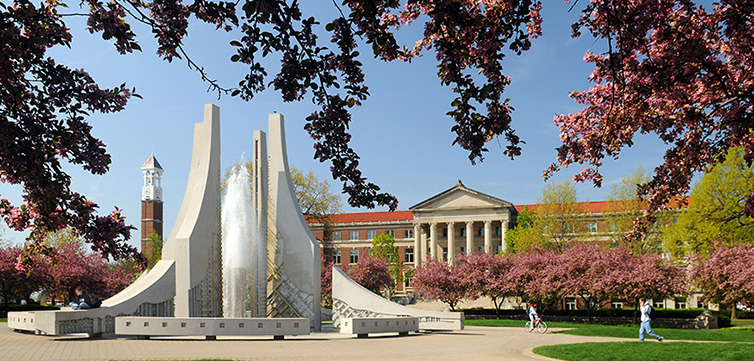
An initial announcement and call for papers is posted on the COV&R website and more information will be added there as it becomes available.
Cobblestones and Mountaintops:
Reflections on the 2019 COV&R Conference
Stephen McKenna
Speech and Writing Consultant
 I arrived in Innsbruck a day early and spent a pleasant afternoon shaking off jet lag, getting my bearings, and strolling about the lovely town center. In the Alpine towns and cities I’ve visited, I’ve often experienced a unique sensation of dislocation spurred by the intense juxtaposition of charming cobble-stone streets lined with handsome old buildings on one hand, and the imposing, sublime aura of the surrounding peaks, the precipitous height and utter massiveness which no photograph can adequately capture. It is an odd but not unpleasant sensation of being in two realities that are yet somehow one. Innsbruck was no exception. The following morning, the first day of the conference, the Tyrolean air was crisp and cool, and the sky was deep blue and cloudless, giving the mountains a seemingly even larger presence than the day before. There were a few hours before the day’s first events, so, perhaps to offset my previous day ambling about town, I took the beautiful ultramodern-looking Nordkettebahn funicular up to Hungerberg, then a series of cable cars that soared over hiking paths below to the Hafelekar summit (elevation 2,334 meters) overlooking the city and the wider Inn valley. It was breathtaking, in every sense.
I arrived in Innsbruck a day early and spent a pleasant afternoon shaking off jet lag, getting my bearings, and strolling about the lovely town center. In the Alpine towns and cities I’ve visited, I’ve often experienced a unique sensation of dislocation spurred by the intense juxtaposition of charming cobble-stone streets lined with handsome old buildings on one hand, and the imposing, sublime aura of the surrounding peaks, the precipitous height and utter massiveness which no photograph can adequately capture. It is an odd but not unpleasant sensation of being in two realities that are yet somehow one. Innsbruck was no exception. The following morning, the first day of the conference, the Tyrolean air was crisp and cool, and the sky was deep blue and cloudless, giving the mountains a seemingly even larger presence than the day before. There were a few hours before the day’s first events, so, perhaps to offset my previous day ambling about town, I took the beautiful ultramodern-looking Nordkettebahn funicular up to Hungerberg, then a series of cable cars that soared over hiking paths below to the Hafelekar summit (elevation 2,334 meters) overlooking the city and the wider Inn valley. It was breathtaking, in every sense.
 The spectacular vistas put me in mind of—what else?—mimetic theory, which so many of us have come to experience as a transcendent vantage point for understanding human history and culture—”a potential Rosetta Stone for the human sciences,” as Woody Belangia has aptly put it. Yet as I thought of this, I couldn’t escape the simultaneously urgent and granular topic of the coming conference: “Imagining the Other: Theo-Political Challenges in an Age of Migration.” For all the scenic beauty afforded by the Hafelekar’s lofty overlook, it was impossible to forget the world-up-close below and beyond the surrounding peaks. Perhaps it was the uncannily clear mountain air that morning that put me in mind of how utterly unveiled our present view of violence around the world is. We see a place that in the last few years has come into ever sharper and more disturbing focus as being in grave trouble: deepening political divisions, often abetted through rampant scapegoating by extremist politicians and parties; the fracturing of long-standing institutional ramparts of relative political stability; the ongoing destruction and scapegoating of our planet; and the chaos and suffering exacted upon so many real human victims, seemingly ever present to us in media accounts and images of social and political violence, so-called “natural” disasters, wars, and a globally widening refugee and immigration crisis. On my flight over, I had surveyed UNHCR estimates of the scale of just the last of these human calamities. As of the day I arrived in Innsbruck, 2019 had seen some 1,300 migrant deaths, an estimated 681 of those in the Mediterranean alone. As I write, that number has surpassed 900. The number of forcibly displaced people worldwide is now a staggering 70.8 million, with some 37,000 added to this every day. We’ve seen many of their faces, and their bodies. There was, and is, no escaping these brutal current realities.
The spectacular vistas put me in mind of—what else?—mimetic theory, which so many of us have come to experience as a transcendent vantage point for understanding human history and culture—”a potential Rosetta Stone for the human sciences,” as Woody Belangia has aptly put it. Yet as I thought of this, I couldn’t escape the simultaneously urgent and granular topic of the coming conference: “Imagining the Other: Theo-Political Challenges in an Age of Migration.” For all the scenic beauty afforded by the Hafelekar’s lofty overlook, it was impossible to forget the world-up-close below and beyond the surrounding peaks. Perhaps it was the uncannily clear mountain air that morning that put me in mind of how utterly unveiled our present view of violence around the world is. We see a place that in the last few years has come into ever sharper and more disturbing focus as being in grave trouble: deepening political divisions, often abetted through rampant scapegoating by extremist politicians and parties; the fracturing of long-standing institutional ramparts of relative political stability; the ongoing destruction and scapegoating of our planet; and the chaos and suffering exacted upon so many real human victims, seemingly ever present to us in media accounts and images of social and political violence, so-called “natural” disasters, wars, and a globally widening refugee and immigration crisis. On my flight over, I had surveyed UNHCR estimates of the scale of just the last of these human calamities. As of the day I arrived in Innsbruck, 2019 had seen some 1,300 migrant deaths, an estimated 681 of those in the Mediterranean alone. As I write, that number has surpassed 900. The number of forcibly displaced people worldwide is now a staggering 70.8 million, with some 37,000 added to this every day. We’ve seen many of their faces, and their bodies. There was, and is, no escaping these brutal current realities.
 Disconcerting as such ruminations were in the high, thin air, I also took some encouragement about the days to come, knowing what mimetic theory can bring to our understanding of this catastrophe. As Jeremiah Alberg would note in his opening remarks later that afternoon, when had COV&R ever met to bring the lens of mimetic theory to a more immediate and pressing set of issues? What perspective could be more apt for thinking about such matters? “The topic chosen for this year’s conference,” said Jay, “is not some merely academic catchphrase being used to give an appearance of unity to a variety of themes. Rather, we are discussing one of the great moral challenges that faces the modern world.” The prospect of all the presentations and conversations to come among such a genial gathering of scholars and friends, despite the vast complexity, sensitivity, and difficulty of the conference topic, made for a more hopeful set of reflections as I descended from the mountaintop.
Disconcerting as such ruminations were in the high, thin air, I also took some encouragement about the days to come, knowing what mimetic theory can bring to our understanding of this catastrophe. As Jeremiah Alberg would note in his opening remarks later that afternoon, when had COV&R ever met to bring the lens of mimetic theory to a more immediate and pressing set of issues? What perspective could be more apt for thinking about such matters? “The topic chosen for this year’s conference,” said Jay, “is not some merely academic catchphrase being used to give an appearance of unity to a variety of themes. Rather, we are discussing one of the great moral challenges that faces the modern world.” The prospect of all the presentations and conversations to come among such a genial gathering of scholars and friends, despite the vast complexity, sensitivity, and difficulty of the conference topic, made for a more hopeful set of reflections as I descended from the mountaintop.
The coming days in the valley at the University of Innsbruck were not to disappoint, and not just because the hosts did such a fine job organizing and running the show. (I for one know what this entails, and I was all too happy to resume the status of mere conference participant!) Here is not the place to rehearse the program, which proffered an interdisciplinary embarrassment of riches. (Not just the problematics of national boundaries but those of disciplinary ones are ever under mimetic theory’s critical and fruitful scrutiny.) The plenaries, incidentally, which were streamed live on the Raven Foundation’s Facebook page, remain available on COV&R’s YouTube channel.
 To mention one highlight apropos of mimetic theory’s radical relevance to the urgent human problems the conference took up, I cite Duncan Morrow’s inspiring presentation, “Geography of Difference in a World of Undifferentiation,” which struck me as definitive on those hard realities of identity and violent conflict that the day before had seemed to me just beyond the next Alpine ridge: “The question of what it means to be a scapegoat, what violence means, how we find our way out of it, whether there are any ways in which we can understand it that help us understand our predicament, are not abstract questions. They are immediately real questions, not simply at the level of even politics—for the politics are very obvious—but actually in the daily lives of the people who are having to live through these realities and make sense of them and act in them.” Duncan remarked that his mentor Roel Kaptein believed that “…essentially everything is a question of mimetic relationships. But mimetic relationship is not an abstract idea. It is a total change in how we understand ourselves: that we live, work, breathe in mimesis.”
To mention one highlight apropos of mimetic theory’s radical relevance to the urgent human problems the conference took up, I cite Duncan Morrow’s inspiring presentation, “Geography of Difference in a World of Undifferentiation,” which struck me as definitive on those hard realities of identity and violent conflict that the day before had seemed to me just beyond the next Alpine ridge: “The question of what it means to be a scapegoat, what violence means, how we find our way out of it, whether there are any ways in which we can understand it that help us understand our predicament, are not abstract questions. They are immediately real questions, not simply at the level of even politics—for the politics are very obvious—but actually in the daily lives of the people who are having to live through these realities and make sense of them and act in them.” Duncan remarked that his mentor Roel Kaptein believed that “…essentially everything is a question of mimetic relationships. But mimetic relationship is not an abstract idea. It is a total change in how we understand ourselves: that we live, work, breathe in mimesis.”
Another way of saying this, perhaps, is that one of the gifts of mimetic theory is to show us how our many realities—sometimes seeming at first even more unlike than cobblestones and Alpine peaks—are also one. As Girardians know, such undifferentiation is potentially a grave threat—unless we are able to understand not only the scapegoat mechanism but that, as Duncan put it, all “identities” are fundamentally nothing other than relationships. If we can see this, we may truly have a clear vantage point—and a very non-theoretical one—from which to address the daunting problem of human violence, including our complicity in it. Indeed, perhaps we may even find the first steps on a pathway out of it.
Book Reviews
For inquiries about writing a book review or submitting a book for review,
contact the book review editor, Matthew Packer.
Mimetic Theory and Christian Orthodoxy
Ann W. Astell
University of Notre Dame
Scott Cowdell, René Girard and the Nonviolent God. South Bend: University of Notre Dame Press, 2018. Pages 330.

Preaching in the Areopagus, Saint Paul turned the attention of his religious, polytheist listeners to an altar dedicated by them to an “Unknown God.” He then proceeded to announce to them the good news of the revelation of this “Unknown God” as the Creator of all things, the Father of the human race, and its final judge. With astonishing brevity, Saint Paul maintains both Christianity’s continuity with the Athenians’ worship, philosophy, and religious poetry, on the one hand, and its radical discontinuity with that dispensation in the person of Jesus Christ, raised from the dead, on the other. I thought of Saint Paul’s brief speech in Acts 17:22–31)—a speech addressing creation, spiritual quest, idolatry, and final judgment—as I read Scott Cowdell’s book, René Girard and the Nonviolent God. Like the adjective “unknown,” the adjective “nonviolent” announces an apophatic starting point in something or someone “hidden” from the ancients, but also partially revealed to them. Like Saint Paul in his rhetorical appeal to the Athenians, Cowdell positions himself before his intended audience as an apologist for Girard’s mimetic theory, which he (together with Girard) claims to be already partially grasped by his readers, secular and religious alike. Cowdell presents Girard’s mimetic theory as something consistent with what his readers already know through faith and reason to be true: “Christian belief need not be bent out of shape to accommodate mimetic theory” (1). Cowdell’s apologia, in short, is for Girard as an orthodox thinker whose “mimetic theory reassures him that his Christian inclinations are deeply in tune with the truth” (85).
If the mimetic theory once served to bring Girard to the faith, that same faith, when practiced by Girard, also exerted an influence upon the development of his theory. While the former movement (from the mimetic theory to the faith) is well known and, in Girard’s own case, indisputable, the latter movement (from the faith to the developing mimetic theory) is less studied and more controversial. We all know the chief sticking points: the goodness of creation versus ontological violence; the human capacity for freedom and positive mimesis versus a contagious, mimetic entanglement; the meaning of the fall and of original sin; the canonicity of the Epistle to the Hebrews; the Eucharist as sacrifice; the social satanic in denial of fallen angels; the redemption understood as a revelation of the scapegoat mechanism; the meaning and function of grace in conversion; Christianity’s place vis-à-vis other religions. Indeed, the relationship of the faith to the mimetic theory is a continuing cause of division among Girardians who either fault Girard for an incomplete or inadequate theoretical development in the light of the faith or insist that the theory as articulated in Girard’s early and middle writings stands complete on its own, apart from Girard’s personal faith and later revisions of the theory. Cowdell’s book weighs in directly on the vexed question of the commensurability of the mimetic theory with the Christian faith.
Assuming New Forms, Exploring New Worlds: Mimetic Theory as Poetics of Emulation
Jeremiah Alberg
International Christian University, Tokyo
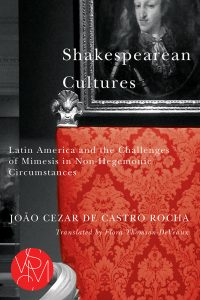 João Cezar de Castro Rocha, Machado de Assis: Toward a Poetics of Emulation. Studies in Violence, Mimesis, & Culture. Trans. Flora Thomson-DeVeaux. East Lansing: Michigan State University Press, 2015. 308 pages. [Machado de Assis: por uma poética da emulação].
João Cezar de Castro Rocha, Machado de Assis: Toward a Poetics of Emulation. Studies in Violence, Mimesis, & Culture. Trans. Flora Thomson-DeVeaux. East Lansing: Michigan State University Press, 2015. 308 pages. [Machado de Assis: por uma poética da emulação].
João Cezar de Castro Rocha, Shakespearean Cultures: Latin America and the Challenges of Mimesis in Non-hegemonic Circumstances. Studies in Violence, Mimesis, & Culture. Trans. Flora Thomson-DeVeaux. East Lansing, MI: Michigan State University Press, 2019. 364 pages. [Culturas Shakespearianas].
I cannot help but begin this review essay with some self-critical reflections. I realize that these reflections implicate others as well, still my intention is not to blame myself nor to look for others to blame but more to try to understand what happened. I ask myself why it has taken four years for a review of João Cezar de Castro Rocha’s Machado de Assis: Toward a Poetics of Emulation to appear in COV&R’s Bulletin, given that was published in the series “Studies in Violence, Mimesis, and Culture,” whose books are often reviewed as soon as they appear. I suspect there are a host of reasons; life is short and there is much to read. The question itself, though, is raised by the very books under review. Rocha ends Machado by quoting from a dialogue between Jean-Claude Carrière and Umberto Eco. In brief, the question under discussion is whether there could be an unknown masterpiece in some “small country.” Both Carrière and Eco are dismissive of the idea. Rocha points to the “naturalization of one’s own place, the effect being a considerable reduction in one’s cultural repertoire,” as the cause of this reaction (M, 246). The one in more peripheral circumstances, on the other hand, “is driven to broaden her references, languages, literatures, and cultures. … This energy lies at the core of the structural intensity that I have associated, potentially, to nonhegemonic 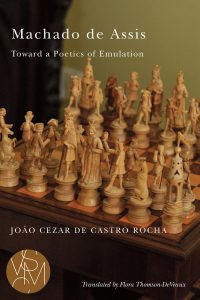 conditions” (M, 246). Mimetic theory itself asks us to examine why it is we do not see the things that we do not see. Girard asks us to direct our attention to our méconnaisance, especially in things connected to desire and conflict, and in these works Rocha raises the question of how authors, who live in “non-hegemonic circumstances,” get to be read by others, especially those occupying positions of hegemony. In spite of our attempts to be inclusive and comprehensive, areas of invisibility remain. I cannot include those I cannot see, even if they are standing right in front of me.
conditions” (M, 246). Mimetic theory itself asks us to examine why it is we do not see the things that we do not see. Girard asks us to direct our attention to our méconnaisance, especially in things connected to desire and conflict, and in these works Rocha raises the question of how authors, who live in “non-hegemonic circumstances,” get to be read by others, especially those occupying positions of hegemony. In spite of our attempts to be inclusive and comprehensive, areas of invisibility remain. I cannot include those I cannot see, even if they are standing right in front of me.
Girard gave us a way to critically appropriate the notion of a canon for literature at a time when the notion was being appropriately challenged for perceived bias against minorities and for dominant groups. According to Girard, the great works were not those that the dominant culture dictated. In fact, great works undercut the dominant cultures that produced them because they revealed the romantic lie on which those cultures were based. The canon was not non-existent, a mere extension of ideological thinking, nor was it to be revised based merely on different ideological thinking. Rather the canon consisted of those works, from any geographical location, from any era, by authors of any sex, religion or race that revealed the novelistic truth of mimetic desire and the variety of conflicts and complications that flow from it.
The challenge was for scholars to make the case that authors already in the canon, like Shakespeare, did this and, similarly, to make the case for those who had been ignored that they had in their own way and at their own time accomplished something analogous to what Shakespeare accomplished as a writer living in Elizabethan England. We have seen these kinds of cases made in Girard’s wake about a wide variety of authors. Rocha has done this for Machado but then expanded it to an even more ambitious project about the culture of Latin America while at the same time refining mimetic theory into a more supple and capacious instrument that loses none of its rigor.
I will give an overview of the two works and then speak of Rocha’s overall project whose groundwork is laid in the first volume and whose execution is begun in the second (hereafter referred to Machado and Shakespearean Cultures respectively).
One can read Machado as an introduction to a writer who is less well-known in the English-speaking world than he deserves to be. But this is not the work of an aficionado pleading the case that his beloved author is worthy of our time and attention. In addition to being an exposition of a kind of writing that Rocha labels “a poetics of emulation,” it is also an argument that there exist structural injustices that determine who gets and who does not get our attention. Further, the larger argument is that part of the greatness of Machado and other writers like him is the way that he developed strategies for transforming this unjust structure into something productive of great literature.
Machado bears comparison with Girard’s book on Dostoevsky. Both deal with the oeuvre of a single author and argue that there is a moment that marks his passage from being a merely good writer to a great writer. Girard argues that 1848 and Notes from the Underground mark a major turning point in the writings of Dostoevsky. Rocha argues that 1878 and Machado’s articles on Cousin Bazilio by Eça de Queirós marks the emergence of the idea of aemulatio. For Dostoevsky it is marked by a certain liberation from the obsessions that had bound him. For Machado it is marked by a certain freedom from the literary tradition that had bound him. He discovers the possibility, beyond the sterile opposition of originality and imitation, of aemulatio. As Rocha defines it, it is “a technique [that] implies the conscious imitation of a previously established model with the aim of adding new elements to it” (M, 57).
Rocha has a very clear purpose in Machado. He will give a “thick description” of the “Machado de Assis literary system” (M, 242). “The most prominent elements of the poetics of emulation are three in number: the distinction between inventio and creatio; the compression of historical periods; and deliberate anachronism. Other elements that stand out are the primacy of reading over writing and the centrality of translation” (M, 130). While no one of these elements is the exclusive property of either Machado or Brazilian literature, the “the strength that I [Rocha] attribute to the anachronistic nature of the poetics of emulation depends on the simultaneous articulation of all these procedures” (M, 243). Chapter 3 spells out in detail what Rocha means by a poetics of emulation. Rocha then writes two chapters in which he explores the “semantic field of emulation in all the genres in which he [Machado] worked” (M, 81). Chapter 4 analyses the years 1878-1881 as the crucial years of Machado’s development into a great writer. Chapter 5 delineates the strategies Machado used in his emulation of other authors. In the course of these two chapters Rocha gives the reader a sense of the many different genres Machado wrote in as well as the variety of sources he “plagiarized.” He also highlights Machado’s appropriation of Shakespeare – a theme that will figure large in the second book.
Rocha demonstrates a structural link between Machado’s oeuvre and the poetics of emulation. In both cases, academic distinctions between text and context, form and content, pale in importance before the continual elaboration of acts of reading and forms of writing that tie together the extremes of the non-hegemonic condition. Rocha’s point is that writers like Machado have taken the disadvantages of the non-hegemonic position and turned them to their advantage, making them productive. They have recognized both the importance of the tradition and their freedom in regard to it.
Rocha sees that the “Achille’s heel” of his hypothesis is that embracing many traditions is common to all literatures and not just Brazil or other non-hegemonic cultures. But he, like Machado, would like to turn this weakness into a strength. This embrace is not some essential element in the Brazilian culture, rather it is a strategy, a practice. It is true this practice is adopted by others but the particular constellation of strategies that appeal to those on the “peripheries” are not haphazard. The imbalance in “symbolic exchange” that exists between those who write in less dominant languages (let’s just say, do not write in English) is real and it has real consequences. Not all of these consequences are negative.
Shakespearean Cultures is an extension and enlargement of Machado. It is also a “non-hegemonic contribution to mimetic theory” (S, 4). It contributes to this theory the concept of “collective interdivduality,” an experience of the mimetic nature of desire on a collective level. It provides the basis for an understanding of Latin American culture as “the historical experience of secondarity” where this secondarity turns “into an unexpected reserve of potential strength, as one moves from programmatic imitation toward the goal of attaining inventive emulation” (S, 142).
Rocha develops his understanding of the poetics of emulation in this broader context of Latin American culture and history: “The poetics of emulation must be understood as a strategy developed in situations of asymmetrical power relations. This strategy takes in an array of procedures employed by artists, intellectuals, writers—inventors, in short—placed at the less-favored side of such exchanges, whether they be cultural, political, or economic in nature. The poetics of emulation is an intellectual, artistic approach to dealing with the situation of objective inequality in which we find ourselves, for example, in comparison to works originally written in English” (S, 142).
Rocha finds in his expansion of mimetic theory resources that suggest “the possibility of framing the poetics of emulation as a strategically non-hegemonic way of dealing with the unavoidable presences of the other in the definition of identity — that is to say in the cases of non-hegemonic cultures and collective interdividuality” (S, 149). For this possibility to be realized the imitation of tradition must lose its connotation of being less and be seen as something more. In other words, Shakespeare as “greatest of plagiarists” and Shakespearean cultures as those who practice inventio rather than creatio.
At this point Rocha makes a decisive move that takes his project beyond literary criticism to an analysis of the dynamics of power in cultural exchange. Rocha points out that seeing the non-hegemonic condition as productive runs the danger of “swapping out the tension of paradox for a comfortable conceptual panacea, translating the objective difficulties of the non-hegemonic condition into unexpected epistemological advantages” (S. 184). Rocha must examine the violence that is part and parcel of Latin American reality. Concretely, he uses the resources of mimetic theory to bring out the double-bind situations that afflict Latin American culture.
One thing that becomes visible here is Rocha’s aemulatio of Girard. Girard began with literature’s revelation of mimetic desire and then followed that line of thinking as it led him to the problem of mimetic conflict and its solution in the scapegoat mechanism. Rocha also began with his analysis of Machado’s oeuvre revealing a mimetic relation with the dominant tradition and now expands this into an analysis of Latin America’s history in the light of “the tension between the Other we venerate and the ‘other other’ we scorn (S, 211). In fact, he states that the final hypothesis of the book is: “the historical condition of Latin America may be best understood as an acute case of the paradoxical structure behind mimetic theory, especially in terms of the relationships determined by double binds of varying degrees of complexity” (S, 216, italics in the original).
According to Rocha, Latin America emerged in the shadow of the Other, an almost absolute model. Thus, one is constantly trying to catch up with the European or North American model. At the same time “the social formation of Latin America was erected upon the systematic exploitation of a significant portion of the population…the ‘other other’” (S. 225). Structurally, this stance means “the victimary disdain aimed at the ‘other other,’ the perfect scapegoat upon which to take out our compulsion to faithfully imitate the Other—a metaphysical desire that haunts us” (S. 226). Rocha characterizes these as the “twin gestures” that “condition the dynamics of Latin American life: the acceptance of the foreign Other; the rejection of the ‘other other’ within our borders” (S. 254)
I cannot do justice to the richness of either book. Together they constitute a significant contribution to mimetic theory, expanding it in fruitful ways, giving its practitioners clues to new ways of creatively applying its insights to both literature and society. We non-Portuguese language readers should be very grateful to have these translations in our hands.
Girard and Lonergan Between and Beyond the Surnaturel Debate
Ryan Hemmer
Marquette University
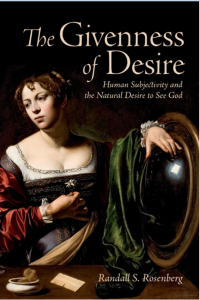 Randall S. Rosenberg, The Givenness of Desire: Concrete Subjectivity and the Natural Desire to See God. Toronto: University of Toronto Press, 2017. Pages xii + 273.
Randall S. Rosenberg, The Givenness of Desire: Concrete Subjectivity and the Natural Desire to See God. Toronto: University of Toronto Press, 2017. Pages xii + 273.
In the years immediately following the close of the Second World War, a conflict of a very different sort raged between the intellectual wings of two French Catholic religious houses—the Jesuits of Fourvière and the Dominicans of la Saulchoir. The central character in this contest, the man who fired the first shot, was the Jesuit, Henri de Lubac (b. 1896–d. 1991). Building on themes developed in his earlier studies of the church fathers, the history of biblical interpretation, and the social dimensions of doctrine, de Lubac’s Surnaturel (1946) presented an understanding of grace, history, and desire that ran afoul of the then still dominant strand of Catholic theology and philosophy known as neoscholasticism. De Lubac criticized neoscholasticism’s theorem of pure nature and the separation it seemed to imply between the natural and the supernatural. A world so divided, de Lubac argued, leads inexorably to a view of nature as given and autonomous, and of grace as a merely extrinsic principle.
Against this “two-tiered” cosmology, de Lubac asserted that the witness of the Scriptures, the fathers, and even Thomas Aquinas himself testified to an innate, natural desire for God and thus to a grace that suffused the natural and the human worlds. Only the recovery of such a notion of grace, de Lubac argued, could meet the contemporary challenges posed by history, politics, culture, and secularity. For his troubles, de Lubac’s neoscholastic despisers accused him of the heresy of Modernism. He was eventually silenced by his own order before being rehabilitated and vindicated at the Second Vatican Council.
In recent years this old continental battle has flared up once again. This latest skirmish, however, is of an Anglophone provenance, occurring in the pages of Nova et Vetera, Modern Theology, and Theological Studies. A fifty-year armistice, moreover, has done little to change the terms of the fight. The same intractabilities have resurfaced and show no signs of a new intellectual resolution. A Girardian-Lonerganian intervention into this once vexed and presently vexing debate is not an obvious project to take up in modern Catholic theology. Yet it is precisely such an intervention that Randall Rosenberg offers in his The Givenness of Desire: Concrete Subjectivity and the Natural Desire to See God. And it is most welcome.
In this remarkable book, Rosenberg accomplishes something rare: he assumes the good faith of every party involved, and works diligently to understand positions fully before bringing new arguments to bear on disputed questions. The first several chapters distill the somewhat fragmentary historical record of the debate as it occurred in the 1940s, beginning, in the first chapter, with Henri de Lubac’s thesis in Surnaturel. De Lubac’s animating concern is for history and the concrete experience of the world. For Rosenberg, any approach to the question of the desire for God adequate to the modern mind must share De Lubac’s concern.
The second chapter articulates and considers the neoscholastic position on the natural desire in light of Lawrence Feingold’s influential book, The Natural Desire to See God According to Saint Thomas Aquinas and His Interpreters (Sapientia, 2010). For Feingold, like his neoscholastic forebears, the desire for God is elicited by the natural knowledge that God exists. If one follows a path of philosophical inquiry to the affirmation of God’s existence, one consequently wants to know what God is, or to know God by his essence. Feingold criticizes de Lubac for confusing the distinction between natural and elicited desire, and thus of losing an integral notion of nature. Feingold challenges his interlocutors “to construct an alternative model that develops the relationship between the natural and the supernatural in a non-extrinsicist way, but that gives priority to the language of Aquinas, especially his account of the supernatural habitual inclination for the vision of God resulting from sanctifying grace” (117). The constructive elements of The Givenness of Desire comprise Rosenberg’s effort to meet Feingold’s challenge by integrating key insights from Bernard Lonergan, Robert Doran, and René Girard.
Chapters 4 and 5 bring the full range of Lonergan’s thought into the conversation, beginning with his own scholastic writings and his essay on the natural desire. Rosenberg lays bare the tension between Lonergan and Feingold, while also providing a way of finding common ground between them. But the discovery of this common ground does not obscure a fundamental difference with far reaching consequences. For Lonergan, unlike the neoscholastics, world-orders precede natures, and the world-order that actually is is one of emergent probability. Such an order is dynamic, unfolding, statistically-structured, mediated and constituted by meaning. Lonergan’s thought reconceives of “nature” not as what remains when one abstracts from all accidental nomoi, but as the intelligible unity-identity-whole of the concrete subject in his or her freedom and operation. Further, with Lonergan and Doran, Rosenberg explores how desire operates concretely under the principle of charity as a mimetic participation in the divine real relations of active and passive spiration.
This positive mimesis worked out in conversation with Lonergan and Doran is the bridge that connects Rosenberg’s project to Girard. The sixth chapter is the most direct engagement with mimetic theory, especially the “other-meditated and socially mediated desire” that Girard articulates (139). Building on Lonergan’s notion of incarnate meaning, Rosenberg introduces the familiar features of dark mimesis and interdividual psychology before insisting on a positive mimetic complement: an account of how the desire for God is mediated through the lives of the saints (148-152). Such desire, when informed by supernatural charity, is a renunciation of dark mimesis and a manifestation of pacific mimesis (156).
The seventh chapter presents two examples of the form of concrete desire and positive mimesis the earlier chapters developed. To find these examples, Rosenberg looks to Thérèse of Lisieux and Etty Hillesum. From the lives of these two quite different modern models of holiness and the theory of imitative participation in the trinitarian relations, Rosenberg attempts to articulate a “metaphysics of holiness” (159) that reveals through concrete living how the universally-offered love of God overcomes dark mimesis and inaugurates a new modality of desire.
Girardian scholars will not find in the pages of The Givenness of Desire a fundamentally new perspective on the interpretation of Girard’s work. Many of the Girardian themes deployed will be quite familiar. Additionally, Rosenberg does not allow his application of positive mimesis to get distracted by a literature review of the different scholarly evaluations and disputations of the matter. I do not think it a controversial claim to assert that the significance of The Givenness of Desire for Girardian scholars is not its interpretation of Girard, but in its application of mimetic theory to larger debates within Catholic thought and theology. Rosenberg shows quite convincingly that mimetic theory has theological significance far beyond its more well-worn applications to questions concerning soteriology. Trinitarian theology, the theology of grace, and even the theology of the saints are all enriched by Rosenberg’s deployment of Girard. The Givenness of Desire will be of interest to anyone looking for a primer on the debate concerning the supernatural, an overview of the thought of Bernard Lonergan, or a creative application of mimetic theory to theology.
Adventures in Originary Thinking
Curtis Gruenler
Hope College
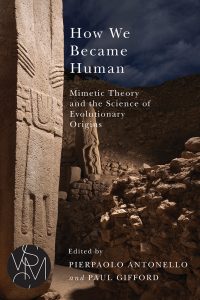 How We Became Human: Mimetic Theory and the Science of Evolutionary Origins. Ed. Pierpaolo Antonello and Paul Gifford. Studies in Violence, Mimesis, & Culture. Michigan State University Press, 2015. Pages liii + 351.
How We Became Human: Mimetic Theory and the Science of Evolutionary Origins. Ed. Pierpaolo Antonello and Paul Gifford. Studies in Violence, Mimesis, & Culture. Michigan State University Press, 2015. Pages liii + 351.
I once heard Bob Hamerton-Kelly, COV&R founder and dedicatee of this volume and its companion, Can We Survive Our Origins? Readings in René Girard’s Theory of Violence and the Sacred, say that mimetic theory, like Darwin’s theory of evolution, would need to be supported for a while from outside usual academic structures. He helped found Imitatio for that purpose, and these two books come from a series of conferences sponsored by Imitatio between 2009 and 2011 at St. John’s College, Cambridge and Stanford University. This Bulletin published a review of Can We Survive in May, 2015 (volume 46, archived at pdcnet.org), but unfortunately no review of How We Became Human has appeared anywhere, as far as I know, until now.
It is a tribute to the organizers and editors to have assembled such a richly interdisciplinary array of contributors as to exceed any reviewer’s professional competence. Both editors hold academic appointments in literature—Pierpaolo Antonello in Italian and Paul Gifford in French—as, of course, did René Girard, and as do I. Something about the ever-increasing interdisciplinarity and eclecticism of literary studies, perhaps, allows more room for this kind of adventure, while at the same time impeding the adoption of any particular theory, especially one with such comprehensive claims as Girard’s. Included here is a piece based on what turned out to be his last public lecture, at the 2008 COV&R meeting, a typically intrepid interpretation of evidence from the Neolithic archeological site at Çatalhöyük in modern Turkey.
Always Already Posthumous
Ann W. Astell
University of Notre Dame
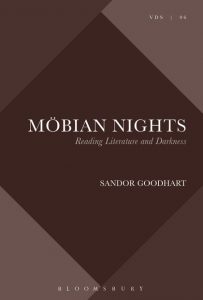 Sandor Goodhart, Möbian Nights: Reading Literature and Darkness, Bloomsbury Press, 2017. Pages 352.
Sandor Goodhart, Möbian Nights: Reading Literature and Darkness, Bloomsbury Press, 2017. Pages 352.
Sandor Goodhart describes Möbian Nights: Reading Literature and Darkness as a companion piece to his first book, Sacrificing Commentary: Reading the End of Literature (Johns Hopkins UP, 1996), which I reviewed with enthusiasm for Shofar back in 1998. That book was, in fact, my first introduction to mimetic theory. I came to Girard (and later, Levinas) through Goodhart. Now, reading Möbian Nights twenty years later, Goodhart returns me to Girard with a fresh understanding. But that same return also makes clearer Goodhart’s own “posthumous” departure from Girard precisely in the conceptualization of what Goodhart calls “the posthumous.”
The word “posthumous” appears only once in The Girard Reader. In the famous chapter from Deceit, Desire, and the Novel called “The Conclusion,” Girard quotes a passage from Marcel Proust’s The Past Recaptured describing the wake before the burial of the great writer Bergotte: “They buried him, but all through the night of mourning, in the lighted windows, his books arranged three by three kept watch like angels with outstretched wings and seemed, for him who was no more, the symbol of his resurrection.” Commenting on this passage, Girard remarks, “Bergotte is famous and Proust obviously is thinking of his posthumous glory…. But this romantic cliché is no more than a pretext in this passage: it is merely an excuse to introduce the word ‘resurrection’…. The death and resurrection of Bergott foreshadow the death and the resurrection of the author himself” (Girard Reader, 60), Proust, who will go on to write his masterpiece, Remembrance of Things Past. In Goodhart’s Jewish aesthetics, there is also life “afterdeath”—even the Messianic resurrection of Israel as a people, foreseen by the prophet Ezekiel in the field of bones (Ez. 37)—but its distinctive literary and critical expression is the “posthumous,” post-Holocaustal life and writing of the once dead and still-mortal “Lazarus,” who lives a survivor’s life, haunted by memories and still subject to suffering and commandment, rather than the impassible life of the risen Jesus.


Excellent issue. Thank you. I especially enjoyed Steve McKenna’s report on the conference.